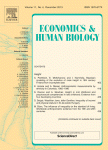Dual burden households and intra-household nutritional inequality in Indonesia
Roemling , Cornelia / Matin QaimExternal Publications (2013)
in: Economics & Human Biology 11 (4), 563-573
DOI: https://doi.org/10.1016/j.ehb.2013.07.001
Information
Overweight is an increasing problem in many developing countries, coexisting with underweight and contributing to a dual burden of malnutrition, sometimes in the same households. We analyze the phenomenon of dual burden households in Indonesia, using 15-year panel data. Currently, 16 percent of Indonesian households are classified as dual burden. In these households, children are often underweight, whereas adults are overweight. The nutrition transition seems to have differential impacts on the body mass index of different age cohorts. Dual burden households are a transitory phenomenon. This phenomenon started in the richer segments, but now the prevalence of dual burden households is highest in the poorest population groups. Most households that move out of the dual burden category end up as overweight. We also develop a continuous Theil index of intra-household nutritional inequality. While the overall prevalence of dual burden households has hardly changed over the last 10 years, the Theil index increased steadily. This underlines that the dual burden classification has limitations in terms of capturing nutritional dynamics. Socioeconomic determinants of dual burden and nutritional inequality are analyzed with regression models.


